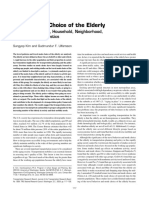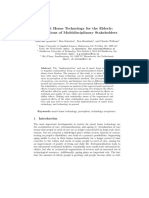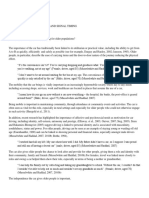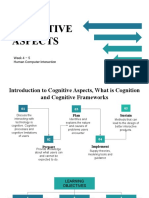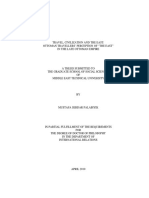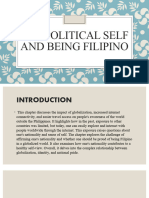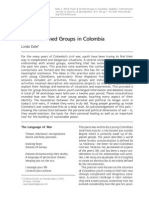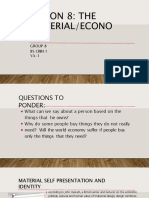Identity
Identity refers to the sense that someone has of who they are, of what is most important about them and what
others think of them. Important sources of identity include nationality, ethnicity, sexuality, gender, age and
social class. Jary and Jary define identity as “a sense of self that develops as the child differentiates from parents
and family and takes place in society” (Jary and Jary, 1991).
Personal identity refers to how a person sees himself/herself while social identity refers to how a person is seen by
others. Sometimes an individual’s personal identity may not match his social identity. For example, a person may
be perceived as male by others but he may feel as a woman trapped in a man’s body.
According to postmodern theories, identity frequently changes. For example, a person who retires will experience
a big change in his identity. In a same way, a youngster who attains 18 years will now be seen differently by law
and society.
The idea that a person’s identity remains the same is nowadays not accepted. According to postmodern views,
people can create, shape or even change their identity. They can choose some aspects of their identity, such as, by
choosing the groups they want to join [e.g subcultures], through plastic surgery, by shopping and consuming
particular goods, by joining a particular religious cult.
Identity is socially constructed, i.e, a person acquires his identity through the process of socialisation. In fact, our
identity is closely related to the culture or subcultures to which we belong.
The social construction of age
Age forms part of a person’s identity just like gender, ethnicity or nationality. Some cultures put emphasis on
chronological age, other cultures are more interested in biological age while sociologists are more concerned with
social age.
Chronological age:
It refers to the time elapsed since a person is born. It is the numerical age in terms of days, months and years.
Chronological age decides many aspects of our life. Many things depend upon how old we are, e.g, getting
married, leaving school, voting, retirement.
Biological age:
Biological age is based on the physical development, changes and capacity of people. Having teeth, reaching
puberty, having grey hair are some examples of biological changes in people experience.
Social age:
Social age can be defined as “the norms, values and roles that are culturally associated with a particular
chronological age.” Giddens argues that age should be analysed in terms of social age as age is socially
constructed. It means the meanings, roles and identities associated with being a particular age vary from society
to society. E.g Philip Aries claims that in medieval Europe children were expected to work and take part in adult
social life since a very young age instead of going to school.
Similarly, the meaning of old age varies from society to society. In some traditional societies, the elderly (old
people) are revered for their wisdom and have much importance and power, e.g in China and Japan. In modern
Western societies, old people are seen as non-productive, dependent and outdated.
�The main ages that sociologists have been interested to study are childhood, youth and old age. The parameters
of these 3 phases are not fixed as they vary from society to society, from time to time and from place to place.
Is childhood a social construction?
According to Prout and Tames, childhood has been viewed as a stage of life experienced by every individual.
Hence sociobiologists would argue that childhood is natural and same for everyone. This view arises because:
a. Irrespective of society or time, children are smaller, weaker and less physically or mentally developed
than adults.
b. Children are seen as being closer to nature than adults. Their behaviour is dominated by biological urges.
E.g they cry when hungry or hurt. They have no culture and cannot take active part in social life.
c. Children are seen as simple because they have not yet developed the complex and sophisticated ways of
acting and interacting with one another like adults. For example, children gradually develop the ability to
understand and use complex language as they grow up.
d. Childhood is seen as a phase in which individuals are incomplete persons. Children are considered as
incomplete beings or unfinished products who require support and socialization from adults before they
can participate in society as complete members.
e. Childhood is also a period of dependence when parents and society must provide children with their
needs. They lack the strength, wisdom and maturity to care for themselves.
f. Children need protection as they are physically weaker and mentally immature. They cannot differentiate
between right and wrong. This is why childhood is also considered as a period of innocence.
Sociologists however argue that childhood is not a natural stage which follows a fixed pattern everywhere. It is
rather a social construction, i.e, something created and defined by society. They argue that what people mean by
childhood, and the position that children occupy in society, is not fixed but differs between different times and
places. The socialisation of children in different societies or cultures is different and affects the experiences of
children. Childhood is also shaped by different social divisions such as ethnicity, class or gender.
THEORIES AND ARGUMENTS WHICH SUPPORT THE VIEW THAT CHILDHOOD IS A SOCIAL
CONSTRUCTION
a. The theory of childhood as a social construction by Philip Aries [historical differences in
childhood]
Philip Aries explained the idea of childhood being socially constructed through the historical changes in childhood
in Europe since medieval times (12th to 16th century).
In medieval times, the modern conception of childhood did not exist. Aries says that
“as soon as the child could live without the constant solicitude of his mother, his nanny or his cradle-rocker, he
belonged to the adult society.”
� Many children at that time did not even know their chronological age since it had little significance. At that time,
children were not accorded the importance attached to them today. For example, parents did not get painters to
do portraits of their children, mourning was kept to a minimum when the child died. Aries commented that:
“Childhood was simply thought as an unimportant phase of which there was no need to keep any records. Also, in
the case of a dead child, it was thought that the little thing that had disappeared was not worthy of
remembrance.”
According to Aries, at the start of the medieval period children were seen as miniature adults who were expected
take on adult roles at around the age of seven. They were expected to work and look after themselves. They could
even marry very young and they were treated as criminals if ever they committed crimes. There were little
difference between children’s and adults’ games and leisure times. They even dressed like miniature adults as
there were almost no specialist clothes for children. In addition, children were not considered as innocent and
needing the protection of adults. E.g it was considered normal to make sexual references to children or even to
touch children’s genitals.
Towards the end of the medieval era, modern ideas of childhood started to emerge . Children’s toys and clothes
were introduced. People started keeping paintings or portraits of children. Children’s deaths were mourned and
taboos about children and sexuality developed. Aries argued that society gradually started to accept that children
were not ready for adult life and responsibilities and they had to be subject to special treatment. Society started
to become much more concerned with children. Today the world has become child-centered and children are very
much protected. Aries concluded that nowadays “the world is obsessed by the physical, moral and sexual
problems of childhood.” He claims that a ‘cult of childhood now exists’.
The reasons for this are:
Most important of all reasons was the development of schools. With industrialization and rapid changes in
technology, there was an increasing need for a literate and numerate labour force. As more children went sent to
school, they became increasingly separared from adult world. Children became more dependent on parents and
other adults. They also became liabilities instead of being considered as economic assets. People started having
fewer children. The period of dependency is in fact getting even longer today as young people spend more time on
education and training.
With developments in medical care and better living standards, more children were surviving in adulthood.
Consequently children achieved more importance as they were no longer viewed as ‘temporary beings’ with a
short lifetime.
Increase of nuclear and smaller family further contributed to the new and more important position of children.
Living separately from grand-parents and other relatives, parents were having fewer children and more family time
to give to their children.
With industrialization, standard of living improved and also parents started having reduced working hours. They
were able to spend more money and time on their children.
Children were now seen as an important investment for the future. They could be the means by which the family
can progress and move to higher social position. So, they became more important for the family
New laws in favour of children were passed. Attendance at school became compulsory in the 1880s meaning that
all children were not allowed to work. The school leaving age was also gradually raised. This extended the age of
dependence of children. Child labour and child marriage became illegal.
By the 20th century, specialist sciences such as child psychology and paediatrics developed which further helped
to understand the needs of children and provide them with more rights. Society, especially parents learnt that
children must be protected from neglect, abuse and trauma.
� The work of Aries has generated considerable discussion and debate. The following criticisms have been put
forward:
1. Aries’ work has been seen as subjective. His work point out that the modern child centered view of society is
superior to views of the past which allowed children to be treated in different ways that are considered
unacceptable today. Critics have argued that Aries has used his own values to be over critical of medieval child
rearing.
2. Aries has also been criticised for arguing that there was no concept of childhood in medieval times. Critics have
suggested that it would be more accurate to say that the ideas of childhood were simply different at that time.
3. Aries also generalised about childhood on the basis of data largely confined to French aristocratic families. His
conclusions were largely based on family portraits of medieval times. The data he used was too restricted and
cannot be used to make generalisations.
b. Differences in childhood within the same society
Childhood is a social construction as the experience of childhood is not the same for all children within a society. In
Britain and many other societies, with differences based on social class, ethnicity and gender mean, all children do
not have same experiences as they grow up. E.g many children ( About 30 %) in Britain live in poverty. Such
children are more likely to suffer from malnutrition, ill health and failure in education whereas children of wealthy
families enjoy high quality food, medical care and access to best educational institutions. Some children are forced
to take up small jobs such as paper rounds or working in shops to get pocket money or help family expenses.
Oakley supports the idea that childhood of a girl is very different from a boy’s childhood. While girls play with
dolls, help with housework and are encouraged to be docile and neat, boys are given cars or construction sets.
They are allowed to dirty themselves playing sports and enjoy much more freedom.
c. Cross-cultural differences in childhood
If childhood was natural the experiences of children would be similar across societies. There is however much
difference between western view of childhood and many other societies. In modern industrial societies, children
go to school, take responsibilities late and are much protected. Chagnon found that among the Yanomamo of
Amazonian forest, girls are expected to run a house by the age of ten. They are married and start having children
by the age of 12/13. Child labour is still a reality in many countries such as Bolivia and India.
Likewise, not all societies treat children as innocent and needing protection. In many countries, such as Sudan and
Afghanistan, children have been used as soldiers to fight wars where they have been involved in brutalizing and
killing others. Many child soldiers have also been brutalized and killed. Girl soldiers are frequently subject to rape
and other forms of sexual violence. In Sri Lanka, poor parents sell their daughters.
� Youth as a social construction
Functionalists such as Parsons and Eisenstadt argue that ‘youth’ is an important stage providing a period of
transition between childhood and adulthood. This involves withdrawal from full time education and a move
towards full employment; and a move away from the family of origin and parents’ household towards their own
household.
Youth, in fact, includes a range of identities such as teens or adolescents and young adults. In modern industrial
societies, youth can last up to the twenties or beyond as youngsters remain financially dependent on their family
due to full time education or unemployment.
In all societies, youth is partly associated with puberty. Puberty is a universal biological phenomenon involving
changes such as the development of secondary sex characteristics, the development of reproductive organs, the
development of strength and endurance, etc. However, puberty varies between and within societies and also
overtime as it depends on environmental factors such as diet and stress.
Furthermore, although puberty in contemporary Britain takes place in the early teenage years, ‘Young people are
not regarded or treated as adults merely because their bodies have matured’, said Pilcher [1995]. Adult rights and
responsibilities are given at different ages by the legal system. For e.g, youngsters are allowed to have sexual
intercourse and marry with parental consent at sixteen but cannot vote in elections, buy alcohol or drive a car
before eighteen.
In some traditional cultures such as tribal societies youth is not recognized as a separate stage of life and people
move directly from childhood to adulthood through ceremonies or rites of passage. E.g the Nandi people of Kenya
mark the passage of boys into adulthood with the circumcision ceremony. For the Bemba people of Zambia, a
girl’s transition to womanhood takes place when she has her first period and she can then get married.
Youth subcultures
A youth subculture is a group of young people who have developed their own particular lifestyles, norms and
values which are somewhat different from the rest of society in terms of their ways of dressing, hairstyle,
activities and leisure pursuits such as music.
Many subcultures were formed by working class youngsters. To Clark et al, youth subcultures do not solve the
problem of working class youth but they do offer imaginary solutions to their problems. It allows them to feel they
are gaining status, protecting their territory and resisting dominant ideologies of society. E.g:
i. Teddy boys [Teds]: a subculture which consisted of unskilled working class youth who wore Edwardian style
jackets, bootlace and suede shoes. They felt that their social status and ‘territory’ was threatened in the post war
period from urban development.
ii. Punks: They wore safety pins and ripped jeans as signs of membership to the subculture. Such dressing was
against widely shared lifestyles and taste of the mainstream culture.
iii. Mods: young working class people adopted a more respectable appearance by wearing suits. This reflected
their aspiration to be upwardly mobile and joining the middle class.
Racism and high levels of unemployment faced by the blacks in Britain led to the development of subcultures such
as the Rastafarians. They adopted simple clothing with an African feel to expression of their own black identity
and resist white dominance.
The Hippies of the 1960s consisted of young people from well off/rich families. They were involved in
consumption of soft drugs such as cannabis and LSD. They pursued a stress free lifestyle and were peace-loving.

